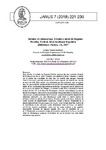Mostrar o rexistro simple do ítem
El Abencerraje. Estudio y notas de Eugenia Fosalba, Madrid, Real Academia Española (Biblioteca Clásica, 33), 2017 [Reseña]
| dc.contributor.author | Vicente Baldrich, Mireia | |
| dc.date.accessioned | 2019-11-25T09:45:17Z | |
| dc.date.available | 2019-11-25T09:45:17Z | |
| dc.date.issued | 2018 | |
| dc.identifier.citation | Vicente Baldrich, M. El Abencerraje. Estudio y notas de Eugenia Fosalba, Madrid, Real Academia Española (Biblioteca Clásica, 33), 2017 [Reseña]. Janus: estudios sobre el Siglo de Oro, 7, 221-230. http://www.janusdigital.es/articulo.htm?id=114 | es_ES |
| dc.identifier.issn | 2254-7290 | |
| dc.identifier.uri | http://hdl.handle.net/2183/24370 | |
| dc.description.abstract | [Resumen] Esta edición, al cuidado de Eugenia Fosalba, presenta las tres versiones distintas de El Abencerraje en un único volumen, que permite al lector consultar y valorar por sí mismo las cualidades de cada una. La versión más antigua, conocida como Crónica es la que más se aproxima al texto original, de carácter oral, escrita no antes de 1548. Esta versión, muy desdeñada por los estudiosos, dejó un espacio muy útil que la editora ha aprovechado con una edición crítica anotada y justificada dentro de las coordenadas interpretativas modernas. La segunda versión apareció en el Inventario de Antonio de Villegas, y la tercera, la más leída y difundida, se insertó al final del libro IV de la Diana de Montemayor (edición vallisoletana). La editora aborda en el estudio introductorio los problemas irresolubles hasta el momento de El Abencerraje: ¿Quién es el autor de la Crónica?, ¿cuál es la evolución textual de las diferentes versiones?, y/o ¿fue Montemayor quién firmó la versión inserta en la Diana? Sobre la autoría de la Crónica, Fosalba apunta a Jerónimo Jiménez de Urrea, hombre de temperamento humanista, militar y escritor, responsable de la famosa traducción del Orlando furioso y la Arcadia, como la más plausible. Acerca de la precedencia de las versiones queda demostrado como la Crónica es anterior a I y D con indicios irrefutables como son las notas eróticas y las palabras malsonantes incluidas en algunos pasajes de C que se tijeretean en I y en D. Finalmente un exhaustivo cotejo de la versión aparecida en la Diana con otras obras de Montemayor avalarían la hipótesis de que el escritor luso está detrás del Abencerraje pastoril | es_ES |
| dc.description.abstract | [Abstract] This edition, in the care of Eugenia Fosalba, presents the three different versions of El Abencerraje in a single volume, which allows the reader to consult and assess for themselves the qualities of each one. The oldest version, known as the Chronica, is the one that most closely approximates the original, oral text, written not before 1548. This version, very disdained by critics, left a very useful critical space that the editor has taken advantage of with a critical edition annotated and justified within the modern interpretative coordinates. The second version appeared in the Inventario of Antonio de Villegas, and the third, the most read and disseminated, was inserted at the end of book IV of the Diana de Montemayor (Valladolid edition). The editor tackles in the introductory study the irresolvable problems until the moment of El Abencerraje: Who is the author of the Chronica?, what is the textual evolution of the different versions ?, and / or was it Montemayor who signed the inserted version in the Diana? On the authorship of the Chronica, Fosalba points to Jerónimo Jiménez de Urrea, a man of humanistic temperament, military and writer, responsible for the famous translation of Orlando furioso and Arcadia, as the most plausible. About the precedence of the versions is shown how the Chronica is prior to I and D with irrefutable indications such as the erotic notes and the mispronounces included in some passages of C that are scissored in I and D. Finally, an exhaustive collation of the version appeared in the Diana with other works of Montemayor would support the hypothesis that the Portuguese writer is behind the pastoral El Abencerraje | es_ES |
| dc.language.iso | spa | es_ES |
| dc.publisher | Universidade da Coruña | es_ES |
| dc.relation.uri | http://www.janusdigital.es/articulo.htm?id=114 | es_ES |
| dc.rights | Atribución-NoComercial-SinDerivadas 4.0 España | es_ES |
| dc.rights.uri | http://creativecommons.org/licenses/by-nc-nd/3.0/es/ | * |
| dc.subject | El Abencerraje | es_ES |
| dc.subject | Tres versiones | es_ES |
| dc.subject | Novela morisca | es_ES |
| dc.subject | Chrónica | es_ES |
| dc.subject | Inventario | es_ES |
| dc.subject | Diana | es_ES |
| dc.subject | Villegas | es_ES |
| dc.subject | Montemayor | es_ES |
| dc.subject | Jiménez de Urrea | es_ES |
| dc.subject | Siglo XVI | es_ES |
| dc.subject | Three versions | es_ES |
| dc.subject | Moorish novel | es_ES |
| dc.subject | Chronica | es_ES |
| dc.subject | Inventario | es_ES |
| dc.subject | Sixteenth century | es_ES |
| dc.title | El Abencerraje. Estudio y notas de Eugenia Fosalba, Madrid, Real Academia Española (Biblioteca Clásica, 33), 2017 [Reseña] | es_ES |
| dc.type | info:eu-repo/semantics/article | es_ES |
| dc.rights.access | info:eu-repo/semantics/openAccess | es_ES |
| UDC.journalTitle | Janus: estudios sobre el Siglo de Oro | es_ES |
| UDC.startPage | 221 | es_ES |
| UDC.endPage | 230 | es_ES |






